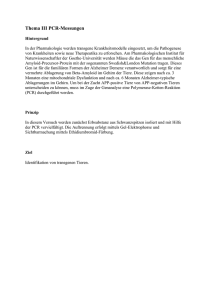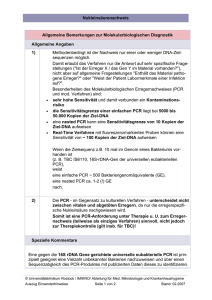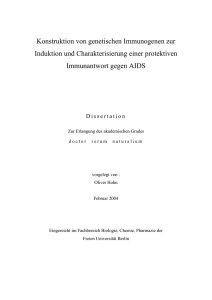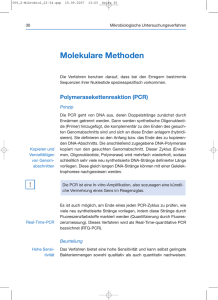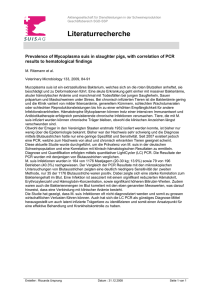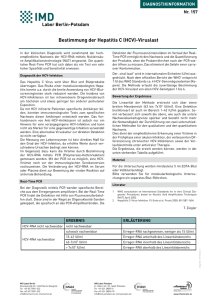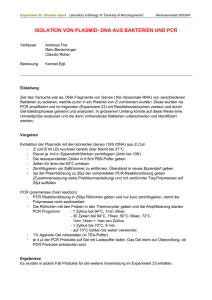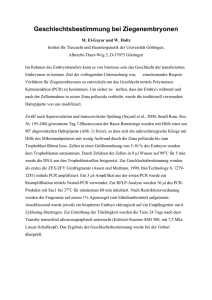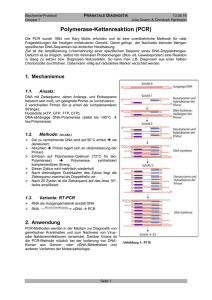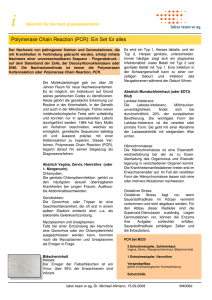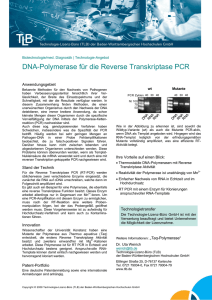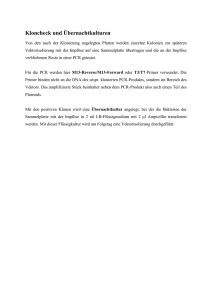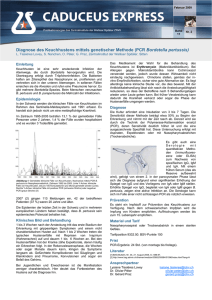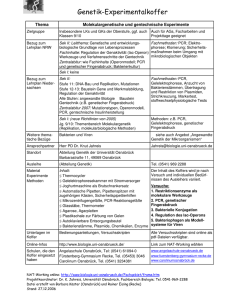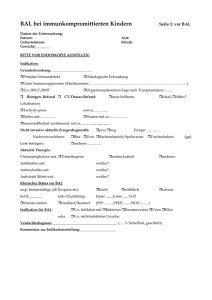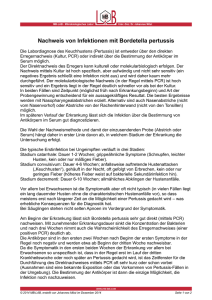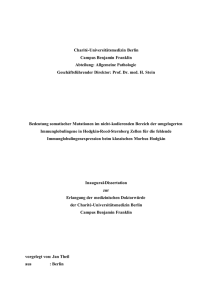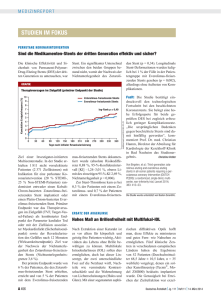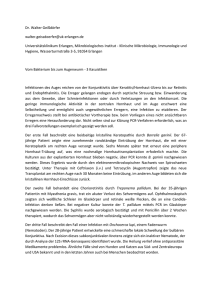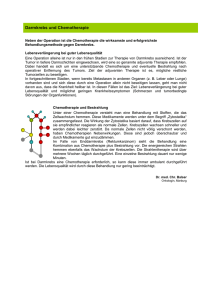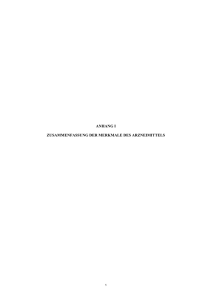Neoadjuvante_Therapie_Mauritius_2006
Werbung
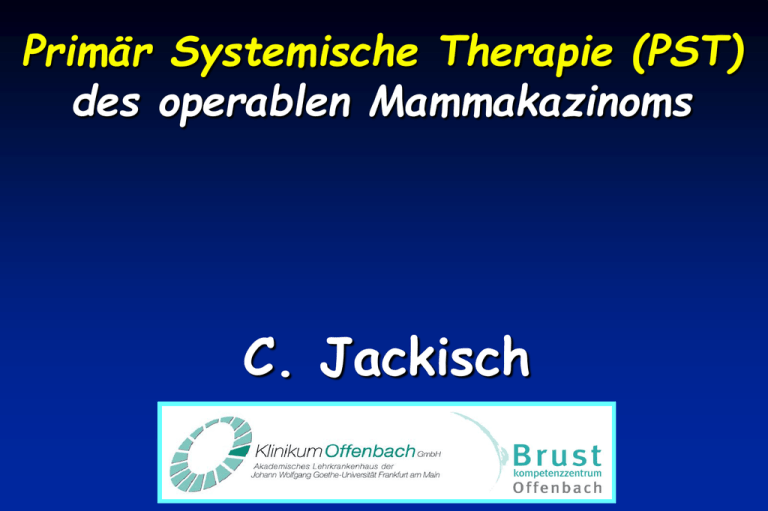
Primär Systemische Therapie (PST) des operablen Mammakazinoms C. Jackisch Operation Chemotherapie Chemotherapie Operation C. Jackisch UFK Marburg Primäres MammakarzinomParadigmenwechsel Dekade Systemische Therapie postop.(adj.) präop. (neoadj.) 1970 1980 N+ N-, Rez.- T4 T3 1990 2000 N-, Rez+ N+, Rez + *T1-2 * T1 Die frühe Elimination der Mikrometastasen vor Resistenzentwicklung ist das Ziel C. Jackisch Primäre Chemotherapie Die ZIELE • Visualisierung des Therapieeffektes • Erhöhung der Rate brusterhaltender Operationen • Erhöhung der Rate pathohistologischer Komplett-Remissionen • Evaluation prädiktiver Faktoren für die Medikamentenauswahl, als in vivo Chemosensitivitätstestung (in Studien !) C. Jackisch Nach 50 Jahren adjuvanter Chemotherapie des Mammakarzinoms gibt es keinen etablierten prädiktiven Faktor für den selektiven Einsatz einer Chemotherapie ! Primäre Chemotherapie Das ZIEL – pathologische Komplettremission (pCR) *Buzdar ASCO 2004 Jahr Regime pCR (%) 1980 CMF 3 1990 EC 6 1999 ADOC 11 2001 ACDOC 22 2003 TAC 23 2004 Taxol + Herceptin* 60 C. Jackisch Indikation zur primären Chemotherapie Oxford LOE / GR AGO Absolute Indikationen: primär inoperables Karzinom 1c A ++ inflammatorisches Karzinom 1b B ++ Optionale Indikationen alternativ zur adjuvanten Therapie: Mastektomie aus onkologischer/ kosmetischer Sicht notwendig, aber Wunsch nach Brusterhaltung 2b C ++ Rezeptor-negatives Karzinom 2b C ++ Kontraindikation zur primären systemischen Therapie mit dem Ziel der BET Oxford AGO LOE / GR multizentrisches Karzinom V D ++ ausgedehnte Mikrokalkareale V D ++ Radiotherapie nicht durchführbar V D ++ Vorteile der primär systemischen Therapie Oxford AGO LOE / GR Überlebensraten sind vergleichbar denen nach adjuvanter Therapie 1b A pCR korreliert mit Überlebensparametern 1b A erhöht die Operabilitäts-Rate bei primär inoperablen Tumoren 1b A ++ Erhöht die BET-Rate bei primär im Sinne einer BET inoperablen Tumoren 1b A ++ Primäre Chemotherapie DIE BRUST THERAPIE DES MAMMAKARZINOMS Primäre Chemotherapie "Neoadjuvante Therapie" NSABP B-18 NSABP B-27 Operables Mammakarzinom Operables Mammakarzinom R R 4 x AC + Tamoxifen 20 mg 5 Jahre Operation 4 x AC + Tam 20 mg > 50 LJ 4 x AC Operation (10/88-04/93) n = 1523 Pat. CR + PR: 79% DFI + OAS: kein Unterschied nach 5 Jahren Relapse: n = 35 ASCO 1997 # 449 Operation 4 x Taxotere® Operation Operation 4 x Taxotere ® C. Jackisch NSABP B-18: Overall Survival Nine Year Update % Surviving 100 90 80 70 60 50 40 0 1 2 3 4 5 6 Years from study entry Postop Preop 7 8 9 NSABP B-18: Overall Survival According to Primary Tumor Response 100 % Surviving 90 80 70 60 pCR 50 pINV cPR cNR 40 0 p = 0.0008 1 2 3 4 5 6 7 8 9 Years from study entry C. Jackisch NSABP B-27 Schema Operable Breast Cancer Randomization AC x 4 Tam x 5 Yrs Surgery AC x 4 Tam x 5 Yrs Docetaxel x 4 Surgery I II AC x 4 Tam x 5 Yrs Surgery Docetaxel x 4 III C. Jackisch NSABP B-27 4x AC 60/ 600 q3w 4x Docetaxel 100 q3w 26,1% 30,0% 25,0% p < 0,001 7,2 14,5% 20,0% 12,9% 15,0% 3,7 10,0% 5,0% 0,0% 9,2 Gruppe 1 (AC OP) (n=762) 4,4 18,9 nur DCIS pCR 10,1 Gruppe 2 Gruppe 3 (AC D OP) (AC OP D) (n=752) (n=772) Bear et al, JCO 2003 NSABP B-27 Overall Survival 100 % Surviving 90 80 70 TRT Group I Group II Group III 60 50 N 801 803 799 Deaths 150 143 HR=0.94 p=0.57 163 HR=1.07 p=0.53 40 0 1 2 3 Years after Surgery 4 5 3-31-04 NSABP B-27: Overall Survival pCR vs. non-pCR Patients 100 % Surviving 90 80 70 TRT Non pCR pCR 60 50 N Deaths 1899 396 409 31 HR=0.33 p<0.0001 40 0 1 2 3 Years after Surgery 4 5 3-31-04 C. Jackisch NSABP B-27: Disease- Free Survival Treatment and Pathologic Response % Disease-Free 100 80 P < 0.00000001 60 40 20 TRT Group I – No pCR Group II – No pCR Group III – No pCR N 668 567 664 Events 236 182 220 Group I – pCR Group II – pCR Group III – pCR 98 200 111 18 40 13 p = 0.42 p = 0.21 0 0 1 2 3 Years after Surgery 4 5 3-31-04 C. Jackisch Primäre Chemotherapie BET Geparduo Studie (N=607pts; retrospektive Analyse) BET-Rate (%) in Abhängigkeit von Behandlung, Zentrum und Ansprechen PST ADoc 70.6 % AC-Doc 78.9 % Pts./Zentrum N<10 62.3 % Clinical Response CR 83.1% N>10 77.8 % PR 71.8% SD 63.3% PD 38.5% C. Jackisch BET/ NSABP B-27 ACOP ACTOP ACOPT Anzahl Tumor Ø 804 4,7cm 805 4,5cm 802 4,5cm Klinisch N+ 30,1% 30,3% 30,8% 62% 64% 62% 56,5% 3% 56,3% 21,2% 56,4% 17,3% BET Alter < 49 Studienabbruch Bear et al, JCO 2003 C. Jackisch Primäre Chemotherapie DIE AXILLA Pathohistologisches Ansprechen Axilla N+ N+ Fisher B. et al. JCO, 1997 NSABP B-18 57 % bei OP 41 % nach PST C. Jackisch Primäre Chemotherapie DER PATHOLOGE Der Teufel steckt im Detail…. Definition der pCR Die NSABP Definition der pCR: Kein invasiver Tumor in der Brust DCIS erlaubt Axillastatus ohne Relevanz Stringentere Definition der pCR: Kein invasiver Tumor in der Brust Kein DCIS als Resttumor Axillastatus frei von Tumor Wichtig: bei Vergleichen zwischen Studien auf pathohistologische Aufarbeitung achten !!! M A M M A K A R Z I N O M Primäre Chemotherapie Disease-free Survival Survival Kuerer HM et al J Clin Oncol 17(1999)460 C. Jackisch Primäre Chemotherapie UNSERE DATEN Brusterhaltende Operationen 80% NSABP B-18 P<0.01 GEPARDUO P<0.01 AC postop AC präop (751 Pat) (743 Pat) ADoc AC-Doc (443 Pat) (442 Pat.) AGO-Trial P=0,02 60% 40% 20% 0 Fisher et al. J Clin Oncol 1998 von Minckwitz, et al. Proc. ASCO 2002 ET CMF ET CMF (112 Pat) (112 Pat) Untch et al. ASCO 2002 Pathologisch komplette Remissionen** BRUST + AXILLA P < 0.01* 20% 15% P = 0.039 **Nach zentralem Review der Histologieberichte = 7.0 (90% CI: 3.6 – 10.5) 10% 5% 14.1% 7.1% AC-T (442 pts) ddAT (443 pts) 0 * Fisher‘s Exact Test for Superiority 15.0% ET CMF (112 Pat) 9,0% ET CMF (110 Pat) Primäre Chemotherapie AKTUELLE STUDIEN Primäre Chemotherapie WIE GING´S WEITER Overall pCR Rates Breast and Axilla Operable Breast Cancer N=258; T 1-3, N 0-1,M0 P q3wks x 3 P weekly x 12 FAC q3 wks x 4 30 25 q 3 wks weekly 20 15 10 Surgery 5 Tam if ER/PR positive n = 127 n = 131 15% p=.01 28% 0 pCR Green MC et al. ASCO 2002; #135 C. Jackisch pCR Rate nach Rezeptorstatus 70 60 50 40 30 20 10 27.5% 61.5% N=11 N=13 25.0% 70.0% N=8 N=10 0 Positive Buzdar A. et al ASCO 2004, abstr 520 Negative P225 + F500E75C500 + Herceptin P225 + F500E75C500 Primäre Chemotherapie OPERATIVES VORGEHEN Primäre systemische Chemotherapie (PST) Dokumentation des Tumorsitz Kaufmann M. et al. J Clin Oncol 2003;21:2600-2608 Brusterhaltung Rate der Reexzisionen 30% 20% 10% 15.8% 18.5% 0 G e r m a n Adjuvant Breast Cancer G r o u p AC-Doc (442 pts) ADoc (443 pts) Primäre Chemotherapie LOKALE KONTROLLE Quality control in the locoregional treatment of breast cancer EUSOMA Qualitätskriterium – Lokalrezidivrate Bei BET: max. 15 % n. 10 Jahren Bei ME: max. 10 % n. 10 Jahren European Journal of Cancer; 37, 447-453, (2001) Primäre Chemotherapie NEXT STEPS Primäre Chemotherapie pCR und HER2 PST: Herceptin® plus Chemotherapie als Phase II Resultate Regimen Patients (n) ORR (%) cCR (%) pCR (%) H qw x 12, D q3w 30 97 73 47 H qw x 12, D q2w, V q2w 17 88 65 42 Sanchez-Rovira 2004 H qw x 12 EC q2w, P q2w, G q2w 39 100 49 33 Moluçon 2003 H qw x 18, D q3w 18 95 67 28 Schiffhauer 2003 H qw x 12, D q3w 16 NR NR 25 Hurley 2002 H qw x 12, D q3w, C q3w 34 NR NR 21 Harris 2003 H qw x 12, V qw 42 88 38 19 Burstein 2003 H qw x 12, P q3w 40 75 30 18 Bines 2003 H qw x 14, D qw 33 70 24 12 Van Pelt 2003 H qw x 12, D q3w 22 77 41 NR Trial Coudert 2004 Limentani 2003 >250 C = cisplatin; D = docetaxel; EC = epirubicin/cyclophosphamide; G = gemcitabine; H = Herceptin®; P = paclitaxel; V = vinorelbine 70–100 24–73 12–47 C. Jackisch Herceptin® plus Chemotherapie als PST: Phase II Safety Daten • Reversible asymptomatische Absenkungen der LVEF wurden bei einigen Patientinnen beobachtet • Es wurden keine neuen oder unerwarteten Toxizitäten beobachtet. • Fazit: Selektion & Monitoring C. Jackisch MD Anderson trial in HER2-positive BC: trial design Stage II–IIIA breast cancer; HER2 positive Randomisation P q3w x 4 H qw x 12 + P q3w x 4 FEC q3w x 4 H qw x 12 + FEC q3w x 4 Local therapy Appropriate endocrine therapy for patients with ER+ disease FEC = fluorouracil, epirubicin, cyclophosphamide H = Herceptin®; P = paclitaxel Buzdar A, et al. Proc ASCO 2004;23:7 (Abstract 520) Randomised trial in HER2-positive operable BC: pCR rates 90 80 95% CI (41–87%) p=0.02 95% CI (43–84%) p=0.016 P + FEC alone H + (P FEC) pCR (%) 70 60 50 40 30 20 10 65.2% n=23 66.7% n=18 25.0% n=16 26.3% n=19 0 DSMB reviewed data (n=34) Final results (n=42) Buzdar A, et al. Proc ASCO 2004;23:7 (Abstract 520) Randomised trial in HER2-positive BC: pCR by ER status 80 P + FEC alone 70 pCR (%) 60 70.0% n=10 61.5% n=13 50 H + (P FEC) 40 30 20 27.2% n=11 25.0% n=8 10 0 ER positive ER negative Buzdar A, et al. Proc ASCO 2004;23:7 (Abstract 520) FAZIT • Die Hinzunahme von Herceptin® zu (P FEC) erhöht signifikant die pCR – pCR von 26.3% bis 65.2% (95% CI:43–84%) • Die Therapie wurde insgesamt gut toleriert; keine symptomatische Kardiotoxizität Weitere Phase III Studien müssen diese Resultate bestätigen Buzdar A, et al. Proc ASCO 2004;23:7 (Abstract 520) Primäre Chemotherapie pCR und ihre Prädiktoren Prädiktion der histologischen Komplettremission Autor ASCO Pat. Faktoren Steger, W. #154 117 Her2 (+), ER (-), PR, p53 Burcombe RJ #1896 96 Her2, ER, PR, Ki67 Krainick UE #3112 34 ER (-), PR,p53,bcl2,Her2, Ki67 Pusztai L #1708 28 BAG1, Bcl2(+) Prädiktion des Ansprechens Parameter Grade ER/PR Her-2 1–2 3 pos. neg. neg. pos. ORR after TACx2 % pCR at surgery % 68.2 81.8 68.0 82.9 71.3 78.4 12.6 28.4 10.1 36.6 16.9 18.9 C. Jackisch Rezeptorstatus als Prädiktor für das Ansprechen Studie n Gepardo 250 Geparduo 913 Gepartrio 286 % Rec - 43.9 26.3 31.9 % pCR Rez Rez + 15.4 22.8 36.6 1.1 6.2 10.1 C. Jackisch Prognostische Subgruppen % pCR Rec negative + sonograph. Resp. 47,3 Rec negative (total) 36,8 Rec positive Risikofaktoren* 8,6 Rec positive + ohne Risikofaktoren* 2,6 * age >35J, cNO, T<5cm, G1-2 Von Minckwitz et al, Ann Oncol 2005 C. Jackisch Before PST During PST After PST DIAGNOSIS P S T SURGERY Core biopsy Core biopsy Surgical specimen A S S E S S M E N T IHC, FISH, DNA array, proteonomics Predictive biomarkers Response Biomarkers* research only Kaufmann M. et al. J Clin Oncol 2003;21:2600-2608 Resistance biomarkers Follow up Verification Schlussfolgerungen • Die effektivsten Substanzen (+Dosis/Dauer) steigern Ansprech-/ Überlebensraten • Dosisdichte Therapie RR (Green ASCO 2002) Trastuzumab + CHTFAC+Paclitaxel RR (Buzdar ASCO 2004) • Optimale operative Therapie ist noch nicht definiert • Prädiktoren für pCR noch nicht definiert • Empfehlungen AGO Mamma 2005 www.ago-online.org
